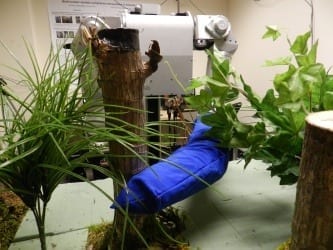
Neurons in the nose could be the key to early, fast, and accurate diagnosis, says a TAU researcher
A debilitating mental illness, schizophrenia can be difficult to diagnose. Because physiological evidence confirming the disease can only be gathered from the brain during an autopsy, mental health professionals have had to rely on a battery of psychological evaluations to diagnose their patients.
Now, Dr. Noam Shomron and Prof. Ruth Navon of Tel Aviv University‘s Sackler Faculty of Medicine, together with PhD student Eyal Mor from Dr. Shomron’s lab and Prof. Akira Sawa of Johns Hopkins Hospital in Baltimore, Maryland, have discovered a method for physical diagnosis — by collecting tissue from the nose through a simple biopsy. Surprisingly, collecting and sequencing neurons from the nose may lead to “more sure-fire” diagnostic capabilities than ever before, Dr. Shomron says.
This finding, which was reported in the journal Neurobiology of Disease, could not only lead to a more accurate diagnosis, it may also permit the crucial, early detection of the disease, giving rise to vastly improved treatment overall.
From the nose to diagnosis
Until now, biomarkers for schizophrenia had only been found in the neuron cells of the brain, which can’t be collected before death. By that point it’s obviously too late to do the patient any good, says Dr. Shomron. Instead, psychiatrists depend on psychological evaluations for diagnosis, including interviews with the patient and reports by family and friends.
For a solution to this diagnostic dilemma, the researchers turned to the olfactory system, which includes neurons located on the upper part of the inner nose. Researchers at Johns Hopkins University collected samples of olfactory neurons from patients diagnosed with schizophrenia and a control group of non-affected individuals, then sent them to Dr. Shomron’s TAU lab.
Dr. Shomron and his fellow researchers applied a high-throughput technology to these samples, studying the microRNA of the olfactory neurons. Within these molecules, which help to regulate our genetic code, they were able to identify a microRNA which is highly elevated in those with schizophrenia, compared to individuals who do not have the disease.
“We were able to narrow down the microRNA to a differentially expressed set, and from there down to a specific microRNA which is elevated in individuals with the disease compared to healthy individuals,” explains Dr. Shomron. Further research revealed that this particular microRNA controls genes associated with the generation of neurons.
In practice, material for biopsy could be collected through a quick and easy outpatient procedure, using a local anesthetic, says Dr. Shomron. And with microRNA profiling results ready in a matter of hours, this method could evolve into a relatively simple and accurate test to diagnose a very complicated illness.
The Latest Bing News on:
Schizophrenia
- Union City man with schizophrenia goes missing day after birthdayon April 27, 2024 at 2:19 pm
UNION CITY, Ga. - A Union City man diagnosed with schizophrenia was reported missing just a day after his 41st birthday. A Mattie's Call, Georgia's emergency missing alert for disabled or elderly ...
- Freedom no therapy in schizophrenia’s black holeon April 26, 2024 at 4:29 pm
On an unseasonably warm late April night, candles flicker in the dark on the grassy slopes that frame Sydney’s Bondi Beach. Hundreds of locals sit quietly on the ground, many weeping, still ...
- Treatment Patch For Schizophrenia: Newly Listed Alto Neuroscience Is Uniquely Positioned In Neuropsychiatry Landscapeon April 23, 2024 at 12:05 pm
Alto Neuroscience reported positive results for its novel PDE4 inhibitor in a Phase 1 study for cognitive impairment associated with schizophrenia.
- Breathtaking News for Depression and Schizophreniaon April 23, 2024 at 8:19 am
As long as there's breath in our lungs our story is still being written.” –Bart Millard Two chemicals from breath samples, butyrate and trimethylamine, are sufficient to distinguish depression and ...
- Physical Ills Often Plague People With Schizophrenia, Bipolaron April 23, 2024 at 5:18 am
Estimates show people with schizophrenia or bipolar disorder are 2.4 times more likely than mentally healthy people to have two or more physical ailments, researchers found. The chronic disease burden ...
- Alto Neuroscience Announces Positive Phase 1 Results for ALTO-101, a Novel PDE4 Inhibitor in Development for Schizophreniaon April 23, 2024 at 1:05 am
Alto Neuroscience, Inc. (“Alto”) (NYSE: ANRO) today announced positive results from its healthy volunteer Phase 1 study of ALTO-101, a novel PDE4 inhibitor in development for cognitive impairment ...
- Having a Cat Can Double Your Chances of Developing Schizophrenia, New Study Sayson April 16, 2024 at 4:06 pm
In a new study, scientists found that those who owned cats before age 25 were about twice as likely to develop schizophrenia.
- Professional Faqs: What Are The Possible Complications Of Schizophrenia?on April 16, 2024 at 2:28 pm
Expert opinion from Gustavo Campos Doctor of Medicine · 9 years of experience · Brazil There are several psychosocial complications related to schizophrenia. Those patients have higher chances of ...
- Parents of Sydney mall killer Joel Cauchi say he was off his schizophrenia medication: ‘He let himself down’on April 15, 2024 at 1:48 pm
Sydney shopping mall killer Joel Cauchi’s father said his son was a “beautiful” boy, who “let himself down” when he went off his medication.
- FDA Puts Clinical Hold on Neumora’s Schizophrenia Drug Due to Preclinical Safety Signalson April 15, 2024 at 6:53 am
Following cases of convulsions in rabbits in a preclinical study, the FDA has placed a clinical hold on Neumora Therapeutics’ Phase I schizophrenia drug candidate NMRA-266.
The Latest Google Headlines on:
Schizophrenia
[google_news title=”” keyword=”Schizophrenia” num_posts=”10″ blurb_length=”0″ show_thumb=”left”]
The Latest Bing News on:
Diagnosing schizophrenia
- Doctor Dharmesh Patel who drove Tesla off cliff with family inside experienced ‘psychotic’ break, psychologist sayson April 27, 2024 at 10:26 pm
Dharmesh Patel, 42, was experiencing hallucinations, hearing footsteps and believed his children had been sex trafficked, two doctors testified at a hearing on Wednesday in Redwood City.
- Understaffed nursing homes in disadvantaged neighborhoods more likely to overuse antipsychoticson April 23, 2024 at 5:00 pm
Nursing homes in disadvantaged communities are more likely to overmedicate residents with antipsychotics, especially homes that are understaffed, according to a new study.
- Why Schizophrenia no longer has to be a life sentenceon April 18, 2024 at 6:18 pm
Until the 1950s, there was no effective therapy and painful experimental treatments, such as brain surgery and sulphur injections, failed. That’s all changed.
- The Bondi Junction attack shocked millions. For people with schizophrenia, there was extra dreadon April 18, 2024 at 6:14 pm
Cameron Solnordal watched the spotlight fall once again on schizophrenia after Joel Cauchi’s deadly attack and revelations he was diagnosed with the condition in his teens.
- Spotlight on 'gaps' in Australia's mental health system in wake of Bondi Junction attackon April 18, 2024 at 3:41 pm
The sister of a man whose schizophrenia diagnosis has been part of her family's life for 30 years says the mental health system, as she has experienced it, is non-existent.
- Presenting schizophrenia as though it satisfies our questions is deeply stigmatisingon April 16, 2024 at 4:34 pm
Implying that the Bondi Junction attacker's metal health diagnosis alone can explain why he decided to attack and murder multiple people is simplistic, offensive and damaging.
- A pet cat could double your chances of schizophreniaon April 16, 2024 at 3:16 pm
For example, one study in the US looked at 354 students and found no association between cat ownership and scores on a schizotypy scale – a questionnaire that helps diagnose schizophrenia. It did find ...
- Parents of Sydney mall killer Joel Cauchi say he was off his schizophrenia medication: ‘He let himself down’on April 15, 2024 at 1:48 pm
Sydney shopping mall killer Joel Cauchi’s father said his son was a “beautiful” boy, who “let himself down” when he went off his medication.
- Famous people who were diagnosed with schizophreniaon April 12, 2024 at 10:55 am
Skip Spence, at one time a guitarist for Quicksilver Messenger Service and at another the drummer for Jefferson Airplane, was highly respected by his peers for his musicianship, but excessive use of ...
- Man's dog helps with schizophrenia hallucinations: Why psychiatric service dogs are helpful, but hard to get.on April 5, 2024 at 7:12 am
When Green sought medical attention three years later, his diagnosis “felt like a death sentence,” he said, because portrayals of schizophrenia are often negative. Research shows that people who feel ...
The Latest Google Headlines on:
Diagnosing schizophrenia
[google_news title=”” keyword=”diagnosing schizophrenia” num_posts=”10″ blurb_length=”0″ show_thumb=”left”]










